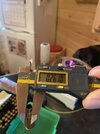westernrover
Member
- Joined
- May 4, 2018
- Messages
- 1,613
I've been using Redding S-type bushing dies to resize my brass.
I'm buying dies for a new-to-me cartridge.
I want to use a Wilson expanding mandrel and die to set the neck size before seating.
I could resize the brass in a Redding S-type bushing die, but a FL die would cost me $130 for this cartridge, plus $15 to $30 for the bushing if I get the right one the first time. I already have the carbide button for this caliber, so after all that, the mandrel doesn't add enough value for another ~$60.
But, if I could resize down a simpler way, then the mandrel would be adding quality for the additional expense.
A Redding non-bushing FL die is $55, but what will it do to my necks? Presumably, it will shrink the necks down enough that the mandrel will push them back open to a desirable dimension to seat the bullet, but what if it sets the neck ID such that the mandrel goes in and out and doesn't do any more? I'll be using Nosler brass.
I'm buying dies for a new-to-me cartridge.
I want to use a Wilson expanding mandrel and die to set the neck size before seating.
I could resize the brass in a Redding S-type bushing die, but a FL die would cost me $130 for this cartridge, plus $15 to $30 for the bushing if I get the right one the first time. I already have the carbide button for this caliber, so after all that, the mandrel doesn't add enough value for another ~$60.
But, if I could resize down a simpler way, then the mandrel would be adding quality for the additional expense.
A Redding non-bushing FL die is $55, but what will it do to my necks? Presumably, it will shrink the necks down enough that the mandrel will push them back open to a desirable dimension to seat the bullet, but what if it sets the neck ID such that the mandrel goes in and out and doesn't do any more? I'll be using Nosler brass.


